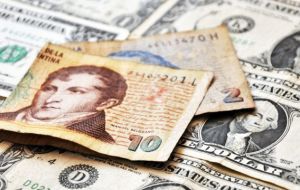MercoPress. South Atlantic News Agency
US dollar in Argentina at an all time record of 16.08 Pesos
 Polls show Buenos Aires governor Daniel Scioli ahead of his top rival, Buenos Aires Mayor Mauricio Macri, but yet unable to avoid a runoff a month later
Polls show Buenos Aires governor Daniel Scioli ahead of his top rival, Buenos Aires Mayor Mauricio Macri, but yet unable to avoid a runoff a month later  Argentina's official peso rate, which is controlled by the central bank, was at 9.405 Pesos per dollar on Friday.
Argentina's official peso rate, which is controlled by the central bank, was at 9.405 Pesos per dollar on Friday. The unofficial or 'blue' US dollar exchange rate in Argentina hit an all-time high of 16.08 Pesos at the end of trading on Friday, due in part to policy uncertainty ahead of the October 25 presidential election, according to local market sources.
Public opinion polls show Buenos Aires province governor Daniel Scioli ahead of his top rival, Buenos Aires Mayor Mauricio Macri. But so far Scioli does not have enough support to ensure he will win the election by a strong enough margin to avoid a second round of voting in November.
Argentina's official peso rate, which is controlled by the central bank, was at 9.405 Pesos per dollar on Friday.
Scioli is the incumbent candidate from the Front for Victory party of outgoing President Cristina Fernandez. He says favors gradual change away from trade and currency controls that have weighed on the economy under Cristina Fernandez.
Macri says a quicker transition toward open markets is needed to increase investment in Latin America's third-biggest economy.
Another factor adding to the demand for US dollars in Argentina, always fearful of their money value, is the even greater uncertainty in neighboring Brazil, Latin America's largest economy and Argentina's greatest trading partner together with China.
Brazil is in the middle of great political and economic uncertainty with calls for the impeachment and removal of president Dilma Rousseff, while the economy is in recession, unemployment and inflation climbing, and the local currency Real has lost almost 70% of its strength vis-à-vis the US dollar. Prospects are for the economic situation to worsen before it begins to improve. Budget deficit is estimated at almost 8% of GDP and Congress reluctant to pass austerity measures.
Likewise Argentina is experiencing a large current account deficit, very short of hard currency despite support from China swaps and the government keeps injecting money to a weakened economy unable to balance the budget.
According to market sources the Argentine central bank was forced to sell 120 million dollars on Friday in a desperate attempt to impede the greenback from flying higher. This means that the gap between the 'official' and 'blue' dollar now stands at over 70%.




Top Comments
Disclaimer & comment rules-

-

-

Read all commentsWell, well, well, I guess the smoke and mirrors of the China currency swap is starting to clear and guess what ---- no dough ! I'm shocked I tell you ! You mean to tell me that the currency swap didn't fix things ? This is an outrage !!
Sep 26th, 2015 - 11:14 am 0Well, in this case I recommend a new barrage of made up facts and statistics. We simply cannot have the low info voter sniffing around and getting confused with the truth. Hurry up with some freshly made up stats. Pull them out of ----, well from wherever you normally pull them out of, but make it quick !!!
lts all the Falklands fault!
Sep 26th, 2015 - 11:54 am 0Why if we had las miserables, er las mistrales, er las you know what l mean, none of this would be happening.
There would be $16 to one peso!
Stubborn lslanders, don't they know that we want to screw them, l mean, liberate them?
We will respect their way of life, (suppressed giggles off stage), respect their language(the same way we respected the Welsh language!),
We will take all their oil, l mean we'll share it out.
Can't understand why there is no takers.
They cannot stop the rot. They have been trying all week to manipulate the market, raiding the caves and using intimidation, but people don't trust the peso. I spoke with a friend in BsAs a few days ago and she said inflation is the main topic of conversation with everyone, it is out of control.
Sep 26th, 2015 - 12:33 pm 0@2 But, of course, it is all your fault. If only they had the Falklands all of Argentina's problems would magically disappear. Fortunately, I can confirm that this is NOT the topic of conversation on everyone's lips. They are too busy trying to survive the raging inflation.
Commenting for this story is now closed.
If you have a Facebook account, become a fan and comment on our Facebook Page!